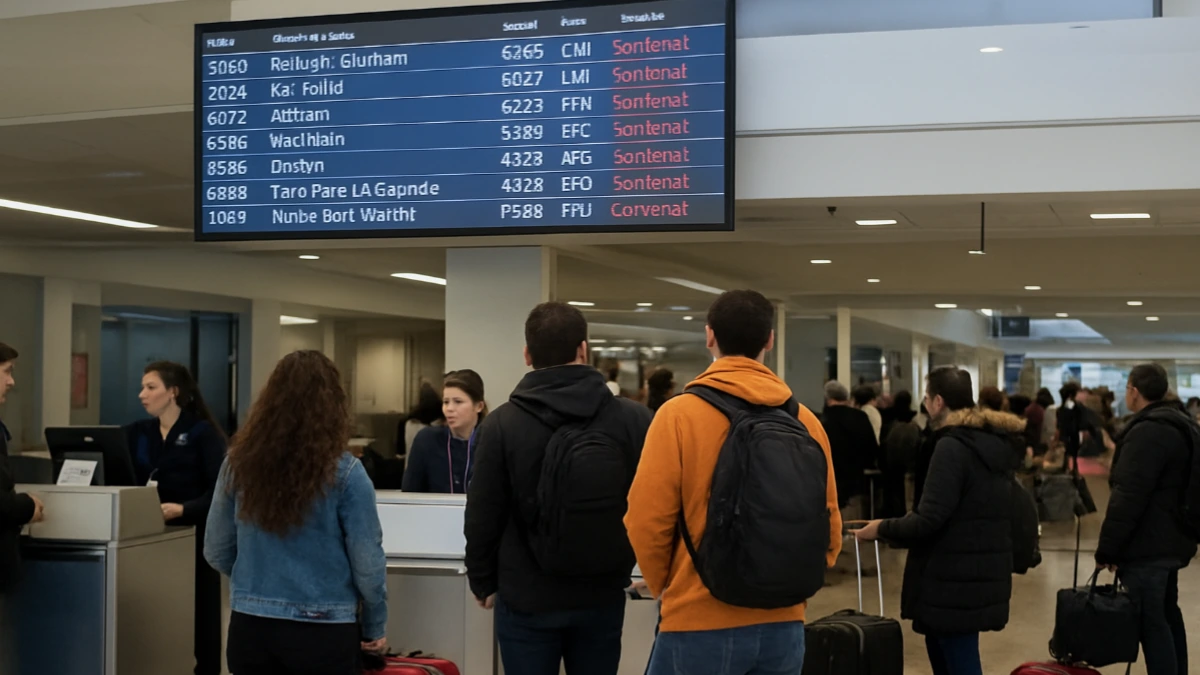By Adnan Rj
November 8, 2025
WASHINGTON — For the second consecutive day, US airlines canceled more than 1,000 flights on Saturday as the Federal Aviation Administration’s (FAA) order to reduce air traffic took hold amid the ongoing government shutdown.
The disruptions, which began Friday, mark the most significant impact yet on the aviation system as the shutdown drags into its fifth week the longest in the nation’s history.
While most airports remained operational, the ripple effects of reduced staffing and air traffic capacity are beginning to test the patience of travelers and the resilience of an already strained system.
“We all travel. We all have somewhere to be,” said Emmy Holguin, 36, who was flying from Miami to visit family in the Dominican Republic. “I’m hoping that the government can take care of this soon.”
The FAA’s order, implemented Friday, requires airlines to cut back on flight operations at 40 of the nation’s busiest airports. Initially set at 4% of flights, the reduction will increase to 10% by Friday, officials confirmed.
The move is part of an emergency effort to cope with mounting staffing shortages among air traffic controllers, many of whom have gone unpaid for nearly a month.
Transportation Secretary Sean Duffy said Saturday that additional cuts “may be unavoidable” if the shutdown continues.
“Safety remains our top priority,” Duffy said in a statement. “We are working with airlines and unions to manage this situation as safely and efficiently as possible.”
So far, the FAA’s slowdown has not caused the kind of nationwide gridlock seen during past crises. Still, the cancellations have added another layer of pressure to an aviation industry already coping with labor shortages, weather disruptions, and heavy holiday demand.
Experts warn that while current cancellations represent a small fraction of total air traffic, the situation could quickly worsen if the shutdown persists.
“This is a slow burn with potentially major consequences,” said Greg Raiff, CEO of Elevate Aviation Group. “Every canceled flight doesn’t just inconvenience passengers it affects cargo shipments, hotel bookings, and tourism related tax revenue. It’s a cascading effect.”
Patrick Penfield, a professor of supply chain practice at Syracuse University, said the broader economic fallout could emerge within days.
Nearly half of all US air freight travels in the bellies of passenger aircraft, Penfield said. “If flight volumes drop sharply, shipping costs will rise and those costs often get passed on to consumers.”
Airlines have already begun shifting resources to mitigate the disruptions, prioritizing long haul and high demand routes while trimming less profitable ones.
“The system can absorb short-term disruptions, but sustained reductions in capacity will ripple through supply chains and consumer markets,” Penfield added.
According to FlightAware, more than 1,050 flights were canceled nationwide on Saturday, following roughly 1,100 cancellations Friday.
The hardest hit airport was Charlotte Douglas International in North Carolina, where 120 arriving and departing flights were grounded by midday.
Major hubs in Atlanta, Chicago, Dallas, Denver, and Orlando also reported elevated cancellation rates, largely tied to staffing shortages and delayed air traffic coordination.
Newark Liberty International in New Jersey experienced slower traffic after several controllers called in sick, the FAA confirmed.
Although Saturday is typically a lighter travel day, analysts warned that disruptions could intensify as the Thanksgiving travel rush approaches.
The Transportation Security Administration screened more than 2.6 million passengers per day during the same week last year a record for the holiday period.
“The system isn’t built to handle a 10% reduction in flight volume at scale during peak travel,” said Mark Hanlon, an aviation operations analyst based in Chicago.
“If the cuts hold through Thanksgiving, we could see major bottlenecks across the East Coast and Midwest.” At Miami International Airport, most travelers said they were aware of the situation but remained hopeful that airlines could manage through it.
“Travel is stressful enough,” said Heather Xu, 46, who was returning to Puerto Rico after a cruise. “Then you put these disruptions in place, and it really makes everything more challenging. Not everyone can afford a hotel or rebook at the last minute.”
Rental car companies reported a spike in one-way reservations Friday and Saturday as passengers sought alternatives. Several carriers, including Delta Air Lines and United, offered waivers for rebooking fees in affected cities.
Still, for many workers, the toll is personal. The National Air Traffic Controllers Association (NATCA) said most of its members are working mandatory six day weeks without pay. Some have taken second jobs to cover bills.
“Controllers are professionals, but they’re human,” said NATCA spokesperson Linda Ferrell. “They’re fatigued, anxious, and under enormous pressure to maintain safety standards while not getting paid.”
The FAA said it expects to reassess the scale of its reductions early next week. If Congress and the White House fail to reach a budget agreement soon, officials warn that deeper cuts could extend into December.
For the travel industry, the timing could not be worse. Airlines are entering one of their busiest seasons, when both passenger and cargo demand surge ahead of the holidays.
“Once you start canceling flights at scale, the ripple effects last for days,” said Hanlon. “Even if the shutdown ends tomorrow, it will take a week or more to rebalance flight schedules and crew rotations.”
Local economies dependent on tourism could also feel the pinch. Cities like Orlando and Las Vegas, which rely heavily on leisure travelers, could see declines in hotel occupancy rates and tax revenues if flight reductions continue through the holidays.
As the government shutdown stretches into its fifth week, its effects are no longer confined to Washington. From air traffic control towers to airport terminals, the strain is spreading across the nation’s transportation network.
The FAA’s gradual reductions may keep skies safe, but the growing number of canceled flights underscores the broader toll of political gridlock. Unless a resolution is reached soon, what began as a bureaucratic impasse could soon ground far more than airplanes.

